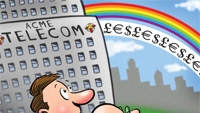Over the rainbow, there's interference

You may have read recently about the debate in the United States regarding white space in the RF spectrum. Although the debate is based on the recent U.S. Federal Communications Commission (FCC) order, there may well be reverberations beyond U.S. shores. White space is unused spectrum in the band allocated to terrestrial TV transmission. This space has long been used by broadcasters for low-powered devices like wireless microphones, talkback and assorted communications devices.
Many nonbroadcasters have eyed this spectrum with glee. It's a precious resource that could be monetized if it can be taken away from broadcasters. Governments, too, have to respond to the ever-increasing demands from the public and business for wireless mobile devices. Because spectrum is precious, should UHF channels be left fallow, waiting for the odd radio microphone? For many this is a privilege that can no longer be granted to broadcasters. The problem is how to use the white space without causing interference to licensed broadcasters.
These problems are not unique to the United States; the same issues occur in Europe, with its crowded UHF bands, and in similarly densely populated Asian cities.
White space devices will be consumer goods, both fixed and mobile, and will be unlicensed. They should be smart enough to find white space before transmitting (sounds a bit like collision avoidance on Ethernet), a measure that is supposed to avoid problems with wireless microphones. The devices must also be capable of establishing their location and, via the Internet, accessing a database of local licensed services in order to avoid transmitting on those occupied frequencies.
If consumer manufacturers find a huge market in the United States, they are bound to want to move across the ocean to new markets. This reminds me of the CB radio. Do you remember that craze? Before then, if you wanted to transmit you had to be a radio ham, with the necessary certification to operate a transmitter. CB was unlicensed, but low power. It introduced a certain anarchy in the 27MHz band, with truckers running linear amplifiers way over the permitted power. If history proves right, then white space devices will also spread beyond the FCC's remit. In densely populated areas of Europe, this has great potential to cause the interference that the U.S. broadcasters fear.
Broadcasters should beware, as the lobbyists that want the right to sell such devices are backed by large corporations that come from sectors outside broadcast. CB was introduced to Europe through gray imports and used illegally in many countries before spectrum was allocated for this clear need from the public. The same could well happen with white space devices. Without Internet access to the licensed transmitter database, the only prevention against interference is the sniff-before-transmit. Many countries already experience problems with unlicensed pirate radio transmission in Band 2; white space devices could potentially add the electromagnetic noise in which licensed operators must function. Regulatory authorities have not been able to control the FM pirates; white space devices are going to be even more difficult.
My feeling is that such products are inevitable and that it is better that they are allowed so that the import and sale can be properly controlled. That way, regulatory authorities can ensure a proper testing regime so that only certified devices can be sold to the public.
The professional video industry's #1 source for news, trends and product and tech information. Sign up below.
Send comments to:editor@broadcastengineeringworld.com
Share your views regarding this topic on the Broadcast Engineering forum at http://community.broadcastengineering.com/forums/80.aspx.
